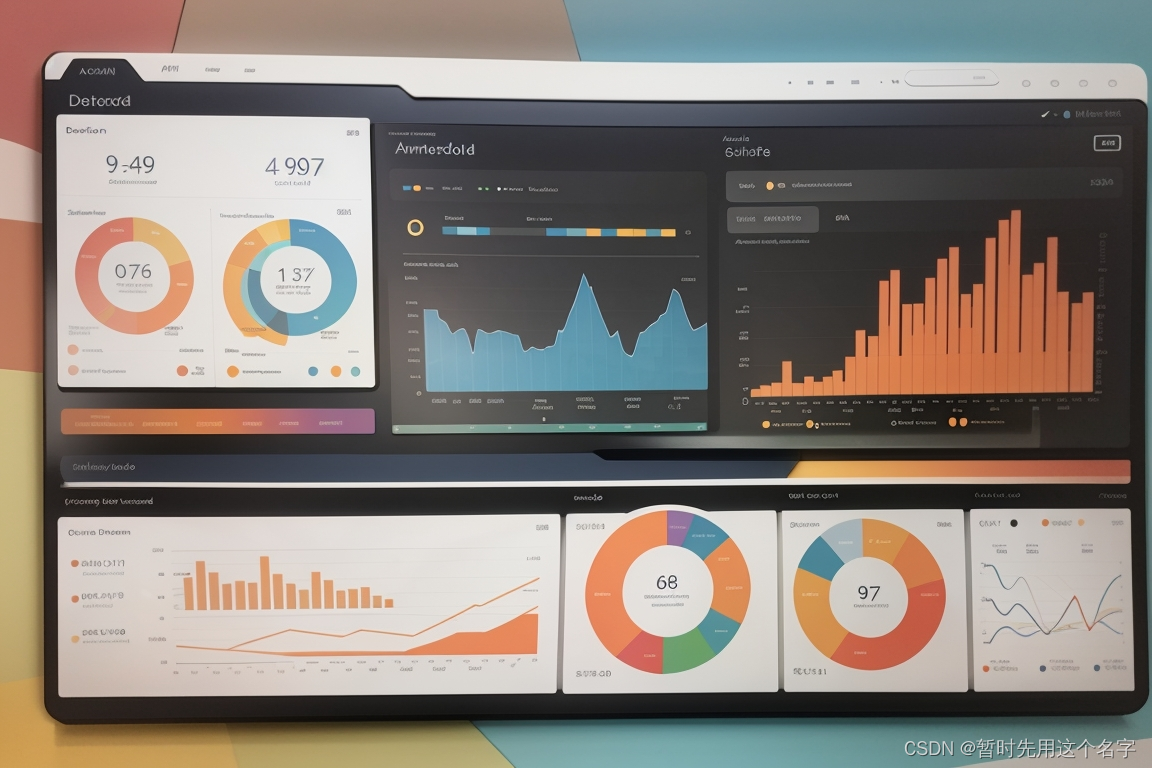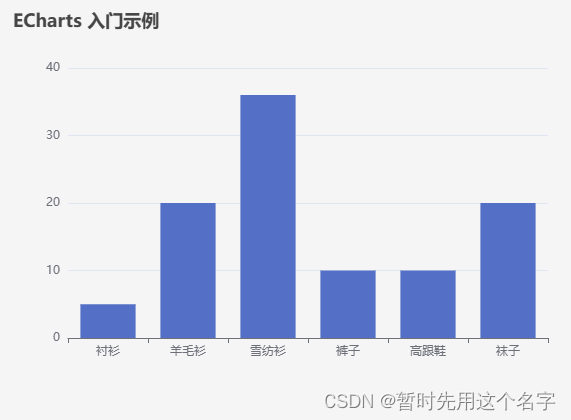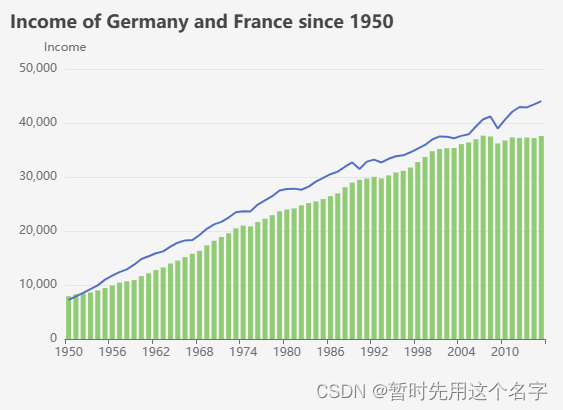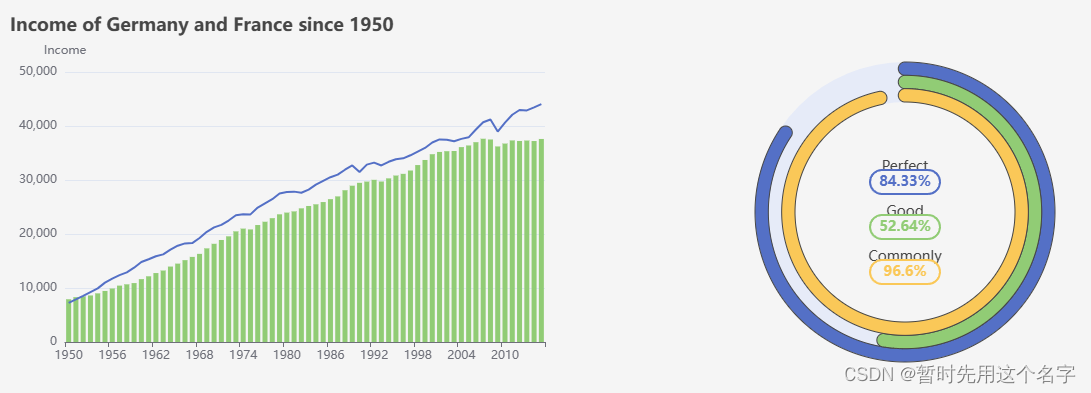- 前端数据展示(数据可视化、数据大屏等)可使用的工具比较多,很多第三方都提供了在线平台,比如阿里云,只需数据接口,在线配置一下界面即可使用。1. 阿里云的使用:利用阿里云物联网平台(IoT)实现WEB数据可视化2. 第三方平台对比:有哪些免费简单的数据展示(数据可视化)网站
- 也可以使用开源代码自己开发前端,本文所介绍的就是
ECharts的开发,这是一款基于JavaScript 的开源可视化图表库,可以流畅的运行在 PC 和移动设备上,兼容当前绝大部分浏览器(IE9/10/11,Chrome,Firefox,Safari等),底层依赖矢量图形库 ZRender,提供直观,交互丰富,可高度个性化定制的数据可视化图表。1. 官方网站:https://echarts.apache.org/zh/index.html2. 官方示例:https://echarts.apache.org/examples/zh/index.html3. 官方指南:https://echarts.apache.org/handbook/zh/get-started/
注意,本文是在Vue3版本下的Element-UI中使用,ECharts官网打开较慢,可尝试翻越。

安装
npm install echarts --save
调用
创建一个
*.vue
页面,实现方法如下三种。
1. 本页数据
修改官方代码:https://echarts.apache.org/handbook/zh/basics/import
<template><divid="main"style="width: 600px;height:400px;"></div></template><scriptsetup>import*as echarts from'echarts'</script><script>exportdefault{data(){return{}},created(){},// DOM 渲染完成触发mounted(){// 基于准备好的dom,初始化echarts实例var myChart = echarts.init(document.getElementById('main'))// 绘制图表
myChart.setOption({title:{text:'ECharts 入门示例'},tooltip:{},xAxis:{data:['衬衫','羊毛衫','雪纺衫','裤子','高跟鞋','袜子']},yAxis:{},series:[{name:'销量',type:'bar',data:[5,20,36,10,10,20]}]});}}</script>

2. 调用数据
修改官方的线性图示例图代码,修改为线性和柱状混合展示图
https://echarts.apache.org/examples/zh/editor.html?c=data-transform-filter&lang=js
另需准备一个json文件,下载自官网:https://echarts.apache.org/examples/data/asset/data/life-expectancy-table.json
本例中将文件放于根目录,本例中路径为:http://localhost/life-expectancy-table.json
<template><divid="main"style="width: 600px;height:400px;"></div></template><scriptsetup>import*as echarts from'echarts'import axios from'axios'import{ nextTick }from'vue'</script><script>exportdefault{data(){return{}},created(){},// DOM 渲染完成触发mounted(){// 数据来源,注意自行修改var url ='http://localhost/life-expectancy-table.json';// 基于准备好的dom,初始化echarts实例var myChart = echarts.init(document.getElementById('main'))// 每隔三秒发起请求,获取数据并绘制图表nextTick(()=>{setInterval(()=>{// 执行this.run(url, myChart);},3000)})},methods:{// 执行run(url, obj){// 调用json
axios.get(url).then(res=>{let option ={dataset:[{id:'dataset_raw',source: res.data
},{id:'dataset_since_1950_of_germany',fromDatasetId:'dataset_raw',transform:{type:'filter',config:{and:[{dimension:'Year',gte:1950},{dimension:'Country','=':'Germany'}]}}},{id:'dataset_since_1950_of_france',fromDatasetId:'dataset_raw',transform:{type:'filter',config:{and:[{dimension:'Year',gte:1950},{dimension:'Country','=':'France'}]}}}],title:{text:'Income of Germany and France since 1950'},tooltip:{trigger:'axis'},xAxis:{type:'category',nameLocation:'middle'},yAxis:{name:'Income'},series:[{type:'line',datasetId:'dataset_since_1950_of_germany',showSymbol:false,encode:{x:'Year',y:'Income',itemName:'Year',tooltip:['Income']}},{type:'bar',datasetId:'dataset_since_1950_of_france',showSymbol:false,encode:{x:'Year',y:'Income',itemName:'Year',tooltip:['Income']}}]};
obj.setOption(option);})}}}</script>
展示图
- 可以顺便学习一下vue3中 nextTick 的具体用法。
3. 异步调用
还是上面的例子(实现略有不同),
setInterval()
中原有的
run()
函数改为了
getOpt()
函数,主要用来学习
axios
如何返回值~~
学习:获取axios的return值
<template><divid="main"style="width: 600px;height:400px;"></div></template><scriptsetup>import*as echarts from'echarts'import axios from'axios'import{ nextTick }from'vue'</script><script>exportdefault{data(){return{}},created(){},// DOM 渲染完成触发mounted(){// 数据来源,注意自行修改var url ='http://localhost/life-expectancy-table.json';// 基于准备好的dom,初始化echarts实例var myChart = echarts.init(document.getElementById('main'))// 每隔三秒发起请求,获取数据并绘制图表nextTick(()=>{setInterval(()=>{// 与上面不同的实现方式this.getOpt(url).then(opt=>{
myChart.setOption(opt);});},3000)})},methods:{// 获取asyncgetOpt(url){let option;// 调用jsonawait axios.get(url).then(res=>{
option ={dataset:[{id:'dataset_raw',source: res.data
},{id:'dataset_since_1950_of_germany',fromDatasetId:'dataset_raw',transform:{type:'filter',config:{and:[{dimension:'Year',gte:1950},{dimension:'Country','=':'Germany'}]}}},{id:'dataset_since_1950_of_france',fromDatasetId:'dataset_raw',transform:{type:'filter',config:{and:[{dimension:'Year',gte:1950},{dimension:'Country','=':'France'}]}}}],title:{text:'Income of Germany and France since 1950'},tooltip:{trigger:'axis'},xAxis:{type:'category',nameLocation:'middle'},yAxis:{name:'Income'},series:[{type:'line',datasetId:'dataset_since_1950_of_germany',showSymbol:false,encode:{x:'Year',y:'Income',itemName:'Year',tooltip:['Income']}},{type:'bar',datasetId:'dataset_since_1950_of_france',showSymbol:false,encode:{x:'Year',y:'Income',itemName:'Year',tooltip:['Income']}}]};})return option;}}}</script>
4. 多表同时
结合两种不同的图标放在一个页面,其中新增一种表为:
https://echarts.apache.org/examples/zh/editor.html?c=gauge-ring
<template><divid="main"style="width: 600px;height:400px;float:left"></div><divid="sub"style="width: 600px;height:400px;float:left;"></div></template><scriptsetup>import*as echarts from'echarts'import axios from'axios'import{ nextTick }from'vue'</script><script>exportdefault{data(){return{}},created(){},// DOM 渲染完成触发mounted(){// 数据来源,注意自行修改var url ='http://localhost/life-expectancy-table.json';// 基于准备好的dom,初始化echarts实例var myMain = echarts.init(document.getElementById('main'))var mySub = echarts.init(document.getElementById('sub'))var option;const gaugeData =[{value:20,name:'Perfect',title:{offsetCenter:['0%','-30%']},detail:{valueAnimation:true,offsetCenter:['0%','-20%']}},{value:40,name:'Good',title:{offsetCenter:['0%','0%']},detail:{valueAnimation:true,offsetCenter:['0%','10%']}},{value:60,name:'Commonly',title:{offsetCenter:['0%','30%']},detail:{valueAnimation:true,offsetCenter:['0%','40%']}}];
option ={series:[{type:'gauge',startAngle:90,endAngle:-270,pointer:{show:false},progress:{show:true,overlap:false,roundCap:true,clip:false,itemStyle:{borderWidth:1,borderColor:'#464646'}},axisLine:{lineStyle:{width:40}},splitLine:{show:false,distance:0,length:10},axisTick:{show:false},axisLabel:{show:false,distance:50},data: gaugeData,title:{fontSize:14},detail:{width:50,height:14,fontSize:14,color:'inherit',borderColor:'inherit',borderRadius:20,borderWidth:1,formatter:'{value}%'}}]};// 每隔三秒发起请求,获取数据并绘制图表nextTick(()=>{setInterval(()=>{// main部分this.getOptMain(url).then(opt=>{
myMain.setOption(opt);});// sub部分
gaugeData[0].value =+(Math.random()*100).toFixed(2);
gaugeData[1].value =+(Math.random()*100).toFixed(2);
gaugeData[2].value =+(Math.random()*100).toFixed(2);
mySub.setOption({series:[{data: gaugeData,pointer:{show:false}}]});},3000)})
option && mySub.setOption(option);},methods:{// 获取asyncgetOptMain(url){let option;// 调用jsonawait axios.get(url).then(res=>{
option ={dataset:[{id:'dataset_raw',source: res.data
},{id:'dataset_since_1950_of_germany',fromDatasetId:'dataset_raw',transform:{type:'filter',config:{and:[{dimension:'Year',gte:1950},{dimension:'Country','=':'Germany'}]}}},{id:'dataset_since_1950_of_france',fromDatasetId:'dataset_raw',transform:{type:'filter',config:{and:[{dimension:'Year',gte:1950},{dimension:'Country','=':'France'}]}}}],title:{text:'Income of Germany and France since 1950'},tooltip:{trigger:'axis'},xAxis:{type:'category',nameLocation:'middle'},yAxis:{name:'Income'},series:[{type:'line',datasetId:'dataset_since_1950_of_germany',showSymbol:false,encode:{x:'Year',y:'Income',itemName:'Year',tooltip:['Income']}},{type:'bar',datasetId:'dataset_since_1950_of_france',showSymbol:false,encode:{x:'Year',y:'Income',itemName:'Year',tooltip:['Income']}}]};})return option;}}}</script>

参考:
Vue Element UI 之ECharts图表
Echarts 在vue3x中使用(包括动态数据变化)
优化了三年经验者的Echarts卡顿
关于vue+elementui 访问本地json和跨域访问API问题
Vue3+ElementPlus+Axios实现从后端请求数据并渲染
Vue3中的Methods用法介绍
Vue3中你应该知道的setup!

版权归原作者 暂时先用这个名字 所有, 如有侵权,请联系我们删除。